Although not your typical pet, lizards can be as fun and exciting to have as the standard cat or dog. You may already have decided on one or are still thinking about getting one. If so, you must have been wondering how you’re gonna feed them. Questions, like “What do lizards eat?” or “How much and how often should I feed them?”, will run through your mind often.
Lizards have different nutritional requirements from our usual furry companions, such as dogs, cats, and rabbits. But once you get the hang of their basic dietary needs, you will find that taking care of your lizard friends can be so simple. Get your answers on what do lizards eat and how to give it to them during feeding time in this article.
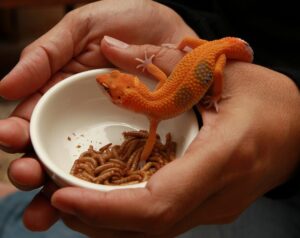
Table of Contents
What Do Lizards Eat in the Wild?
Lizards have a wide range of food that they can munch on. From leafy greens to insects, they have plenty of choices when they are in the wild. Lizards can be
- herbivores (vegetable and fruit–eaters),
- carnivores (meat-eaters),
- insectivores (insect-eaters), and
- omnivores (meat and plant–eaters).
However, a majority of lizards are insectivores and omnivores.
What do lizards eat in the wild may come in a variety of worms, beetles, flies, crickets, and other insects. On the other hand, carnivorous lizards can eat baby mice, baby birds, eggs, snakes, rodents, or smaller lizards. Different species of lizard have different hunting methods, depending on their diet, habitat, and body size.
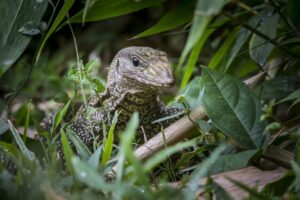
What Do Lizards Eat as Pets?
Feeding your lizard with only one kind of energy source may lead to nutrient deficiency. Below is a list of what do lizards eat, which you can incorporate into your pet’s diet.
1. Live Foods
Owners usually feed their lizards from a diverse choice of crickets, mealworms, or wax worms. Here are some more options that your pet may enjoy:
- Dubia roaches
- Crickets
- Ants
- Small spiders
- Fruit Flies
- Beetles
- Grasshoppers
- Snails
- Worms
2. Fruits
Fruits may be given to lizards, occasionally, as a treat. You may mix them with other foods to make them look more appetizing. Make sure to chop the fruits into little bite-sized pieces to avoid choking. Remove all hard seeds, pits, or peels. Below is a list of fruits that are safe to give to your lizards.
- Apples
- Bananas
- Strawberries
- Raspberries
- Blueberries
- Peaches
- Mango
- Plums
- Papayas
- Melons
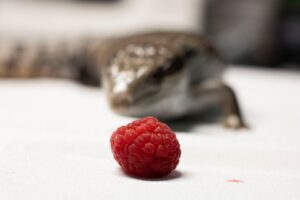
3. Vegetables
Most lizards also have vegetables as their primary food source. Giving them a variety of dark leafy greens decreases the chances of them getting vitamin deficiency. Here is a list of vegetables you can feed to your lizard.
- Kale
- Collard greens
- Spinach
- Romaine lettuce
- Tomatoes
- Carrots
- Squash
- Parsley
However, different kinds of lizards will need different types of nutrients. They will also need the appropriate prey for their size and hunting capabilities. Here, we show you a list of common household lizards and what to feed them.
What Do Lizards Eat According to Species?
1. Chameleons
Immensely popular due to their capability to change color and blend with the background, many people have brought chameleons into their homes. A majority of them originate from Africa. So, chameleons prefer warmer places, such as rain forests and deserts.
With their very long tongues, chameleons eat grasshoppers, crickets, stick insects, and locusts. Larger species may prey upon injured birds or lizards. Chameleons also eat plants when insects are scarce.
Taking care of chameleons can be relatively challenging. On what do lizards eat, most chameleons are carnivores. So you must have a trusted supplier of live feed around you. They like to feast on various insects, including wingless fruit flies, crickets, and waxworms. Meanwhile, veiled chameleons should be given dark leafy greens once per day.
In addition to what do lizards eat, one more thing to consider is that chameleons don’t drink standing water. They drink water by licking droplets off leaves. This can be done by lightly misting the enclosure twice a day.
2. Baby Lizards
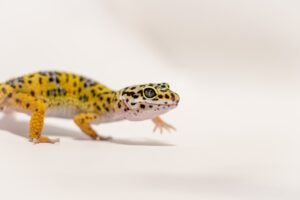
Compared with fully matured lizards, baby lizards need more nutrients in order to grow faster. They also eat more frequently than their adult counterparts. You can give them insects and a few fruits and vegetables. However, because of their body size, they can’t catch prey on their own. Hence, their food should be placed in a small bowl or dish.
To keep your pet lizard from choking, remember that their prey should be smaller than the space between their eyes. They can eat pinhead crickets, bottle fly spikes, flightless fruit flies, and small mealworms.
3. Iguanas
Iguanas, with their long tails and spines, are also a favorite for lizard keepers. These green iguanas are present throughout Central and South America, the Caribbean regions, and the coastal eastern Pacific. What do lizards eat, you ask? For iguanas, it’s mostly fruits and vegetables. But they have the occasional appetite for carrion or invertebrates.
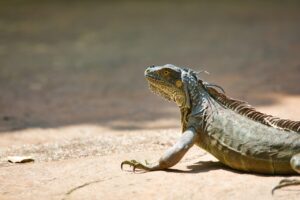
Iguanas need large amounts of dietary protein in the first two to three years of their development stage. Consider giving them insects and spiders to ensure fast growth. Adult iguanas can then switch to a high-calcium, leafy diet.
4. Bearded Dragons
Bearded dragons are called as such due to the distinct “beard” of spikes under their chin that can puff up. In the wild, they can be found across Australia. They prefer warm, arid areas, such as deserts, savannas, and subtropical woodlands. On what do lizards eat, these gentle giants are omnivorous. So, they can eat fruits, vegetables, and insects, or even small lizards or rodents. With their strong jaws, they can crush hard-shelled insects, such as beetles.
Bearded dragons should be given a mixture of fresh greens and live insects daily. They can also have squash, carrots, pumpkins, and cucumbers, with slices of apples, bananas, mangoes, melons, and other fruits as treats. The insects can be mealworms, Dubia roaches, crickets, and earthworms.
5. Geckos
Geckos are more commonly known for having no eyelids. They frequently lick their eyelids to clean them and add moisture in warmer conditions. Geckos will eat anything smaller than their own body weight. So, you won’t have to worry about what do lizards eat when it comes to them. The top choices on their menu are crickets and grasshoppers. But they will also occasionally prey on spiders, scorpions, and other invertebrates.
Crickets and mealworms are the best insects for most lizards, especially for geckos. You can also give them waxworms, butterworms, silkworms, beetles, and cockroaches. Leopard geckos are purely carnivorous, hence they will not eat vegetables. Geckos tend to overeat and get fat, so be careful not to overfeed them. A healthy gecko should have a plump tail smaller than its body, as they store fats in their tails.
Tips and Common Mistakes on What Do Lizards Eat

- Never give wild-caught insects to your lizards, as these insects may carry parasites.
- Adult lizards should grow more slowly compared with baby lizards. If you notice your lizard suddenly gaining weight, it may be a sign that you are overfeeding them.
- Feeding your lizards one variety of food is a common mistake. Doing this can lead to your lizard friends having nutrient deficiencies. It can also lead to metabolic bone disease, especially in herbivores.
- The majority of our lizard companions may still need vitamin supplements even with a varied diet. Incorporate multivitamins and calcium powder in their diet regularly.
- Do research on the possible feed suppliers around you before getting a lizard. Read up on what type of eater your soon-to-be lizard will be. Most people think that all lizard species eat the same thing, but they don’t.
- Iceberg lettuce has little to no nutritional value. Skip this leafy green for your lizard.
- Onion and garlic should be avoided at all costs.
Lizards can definitely be cute and gentle, but feeding them can be tricky. Getting one as a pet means that you should start searching for what do lizards eat.
Remember, most lizards are either omnivores or insectivores. However, it is always helpful to do thorough research on the available food options and lizard care in your community. Make sure to pay attention to their vitamin and calcium intake to avoid vitamin deficiency and other diseases, as well.
Getting a pet may be crucial in your life. They may just be the very thing that saves you. But before getting one, you must do your research and learn how to take care of them. We hope this read was helpful in your journey to becoming a lizard parent!
What do lizards eat mostly?
Do lizards drink water?
Do lizards bite?
How long can lizards live inside a house?
How long can a lizard last without food?
How long do little lizards live?
Are wild lizards friendly?
Do lizards sleep?
What attracts lizards to your house?
How often does a lizard eat?
